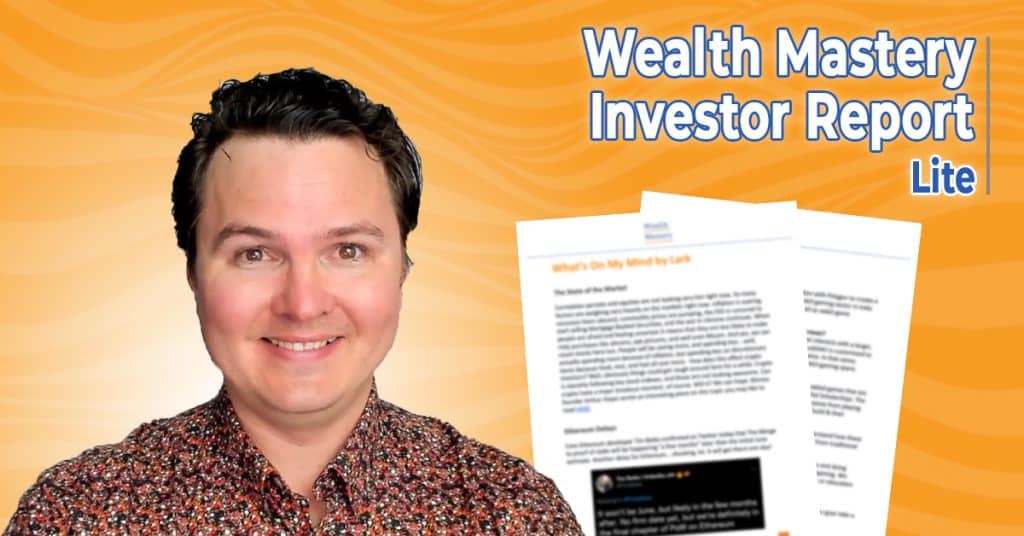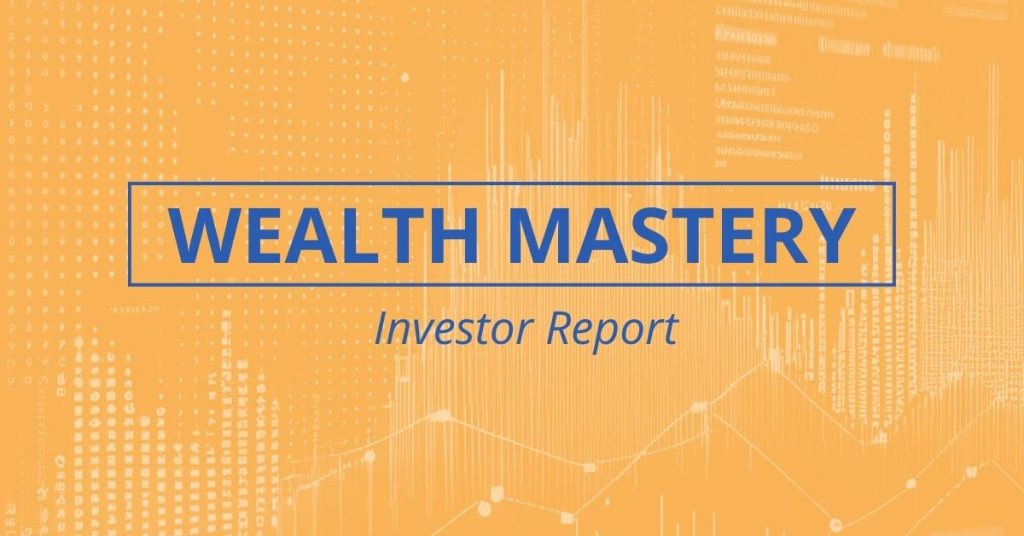The Team from Elrond & Non Dollar Stablecoins

In This Issue
- The team from Elrond discuss what they’ve been up to since we last spoke as well as what they have planned next.
- Erik has a report for you on non dollar stablecoins.
Before we get started, I’d like to remind you that this is your last chance to complete the survey and claim your free trial.
Your opinion is extremely important. Our goal is to improve Wealth Mastery as much as possible so you can maximise your portfolio returns!
Simply click here to complete the survey and claim your free trial!
Elrond Inverview
More than a year ago we interviewed the Elrond team for Wealth Mastery, and I am very excited to welcome them back to learn about some major updates and technical progress.
Also before we begin I wanted to highlight that the Maiar Dex has recently suffered a bug and has spent time offline in the last week.
If you want to inform yourself about this situation then I suggest you check THIS out.
<h3 id="what-are-the-biggest-updates-since-we-spoke-last-time?“>What are the biggest updates since we spoke last time?Most recent milestones:
- Romanian Central Bank approved Elrond acquisition of EMI Institution Twispay
- Elrond acquired Utrust – a crypto payments provider that allows any merchant to accept crypto payments which are automatically converted to fiat
- The Ad-Astra Portal bridge connecting Elrond & Ethereum is live
- Metabonding: a community bootstrapping product for Elrond startups
- Metastaking: a Maiar DEX unique innovation that combines staking, liquidity providing and yield farming into one powerful product
- A new listing process involving a price discovery mechanism has been introduced on the Maiar DEX
- Maiar DeFi Wallet: browser extension for Elrond dApps
- Elrond integrated Anchain’s blockchain analytics suite to allow institutional grade AML
- Itheum is building a new data driven economy on Elrond
- Holoride VR technology will be introduced into several Audi models by June 2022
- Skynet EGLD Capital raised $40+ Million USD to invested in the Elrond Ecosystem
The recently launched Ethereum bridge is just one out of the many pieces of the puzzle slowly coming together in the vibrant and expansive Elrond Ecosystem as of late.
It connects the Elrond and Ethereum, enabling the free flow of tokens between them.
The implications of this tremendous achievement are hard to overstate, fostering growth for everybody involved and opening new paths to innovation.
A wide range of projects, together with their builders, investors, and the communities backing them will be able to get a taste of what true speed, scalability, and decentralization look like, further accelerating adoption.
<h3 id="what-is-the-progress-on-the-elrond-nft-marketplace?“>What is the progress on the Elrond NFT marketplace?Development for the Elrond NFT Marketplace has reached the final stages.
More to be announced soon ⏳
Metabonding is a new community program on the Maiar Exchange that helps boost the reach of projects building on Elrond.
In essence, it is the ultimate community bootstrapping product for Web3 startups.
Projects can apply to take part in the program by establishing a long term commitment with the most hardcore community members, by distributing ~10% of their token supply to EGLD stakers and LKMEX stakers, over the course of 2 years.
There are currently 5 projects, with new ones to be added soon.
The projects registering for Metabonding, will see a rapid adoption taking place in the Elrond ecosystem, benefiting from:
- Awareness from the entire Elrond community
- Listing on the Maiar DEX and Maiar App (exposure to 1M users)
- Access to staking program templates on the Maiar DEX & fiat on ramps.
- Trading competitions & Learn and Earn/ Social campaigns
The distribution of rewards will be segmented between two types of users.
Firstly, users who stake EGLD and secondly, users who stake LKMEX in the special pool that can be found on the Metabonding page.
Based on staked EGLD/LKMEX daily snapshots, there is a weekly average used to determine each address share of the reward pool on that week.
Participants can claim their rewards from all participating projects in Metabonding on a weekly basis.
<h3 id="can-you-tell-us-a-few-examples-of-some-of-the-applications-being-built-on-elrond?“>Can you tell us a few examples of some of the applications being built on Elrond?Beniamin’s recent twitter thread on the Elrond ecosystem sums up the current promising live/ under development applications building on Elrond.
Gaming is a core part of the Elrond ecosystem, given that it has the ability to revolutionize the way we interact with entertainment.
We are fully committed to making sure that games will be a driving force behind the Elrond blockchain adoption, so much so that recently we have announced an investment into the Cantina Royale project.
Besides that, we have also spotlighted some of the most exciting projects currently under development from the Elrond community.
<h3 id="what-comes-next-for-elrond?“>What comes next for Elrond?- Crypto Debit Cards
- More Launchpad projects
- Growth phase for Utrust
- Maiar App 2.0
- NFT Marketplace
- Elrond conference (potential)
- Hackathons
Non Dollar Stablecoins by Erik
Having a look at the most popular stablecoins, we don’t see any non US dollar stablecoins in the top 10. Why is that? And how could a larger market for non USD stablecoins be accomplished?
The degree to which US dollar stablecoins outnumber other types of stablecoins (euro, pound, etc) is staggering.
Just compare the top dollar stablecoin by market capitalisation USDT (Tether) to a top euro stablecoin EURS (Stasis Euro).
The market cap of USDT is 72 billion. The market cap of EURS is around 130 million. That’s around a 500 x difference, which is totally out of whack with the balance between ‘real’ dollars and euros in circulation (about 3 to 1).
Maybe surprisingly, the largest market for stablecoins besides the dollar is … gold-backed stablecoins.
<h3 id="why-are-non-dollar-stablecoins-less-popular?“>Why are Non Dollar Stablecoins Less Popular?Even the most adventurous algorithmic stablecoins like DAI peg to the good old dollar.
Why? There are two main reasons why the vast majority of stablecoin volume is dollar stablecoin volume:
- Most people want dollars. It’s still the dominant medium of exchange: world trade is still largely in dollars. People in large parts of the world want and accept dollars. Migrants who send money to relatives in their home country are likely to choose dollars. When shit hits the fan in the world economy, the dollar is the currency that rises in value against other currencies. So it’s no surprise that not just real-world goods like oil are priced in dollars, but so are crypto currencies. Probably the biggest pull for US-pegged stablecoins has been their utility of collecting yield in DeFi.
- Non dollar stablecoins are a less profitable business model for the companies that issue them. The issuers of ‘traditional’ (collateralized) stablecoins back their issued stablecoins (we hope) with real dollars. Now mind this: the interest rate on dollar accounts in the US is higher than on euros in the eurozone. The interest rate for institutional lenders In Europe is even negative. The same goes for the yield on US treasuries versus EU bonds (US treasuries are ‘dollar equivalent’ and accepted as collateral for stablecoins by auditors). So there is just less room to arbitrage the yield on ‘real’ euros versus euro stablecoins, compared to dollars. Another issue is that the collateral of the stablecoin issuers has to be highly liquid. When holders of the stablecoin decide to go for a ‘bank run’, the issuers need to be able to sell their dollar stash on a moment’s notice. The US treasury bond market allows for that, as it is the most liquid and deep market in the world.
Even though the dollar is the most obvious choice to peg a stablecoin to, there are endless other options. After all, you can peg a token against anything. But the following are some of the most sensible options for stablecoins to be pegged against:
- Another currency, like the euro or yen
- A weighted basket of sovereign currencies (Facebook’s Libra was intended to be such a stablecoin)
- Gold
What are the Most Important Non USD Stablecoins?
The most important alternatives to dollar stablecoins are gold stablecoins and euro stablecoins.
Gold-backed stablecoins
A big advantage of a gold-backed stablecoin is that while it tracks the price of gold, it is better divisible and transportable.
Needless to say, buying stablecoins is much easier than going to a gold shop.
Having said that, nothing of course can beat the zero counterparty risk of storing your own gold.
Most gold stablecoins track the price of one ounce of gold and are redeemable for actual gold.
The latter is only possible with large sums. Redeeming smaller sums of gold tokens is better done through dollar stablecoins.
The biggest gold stablecoins are:
- Paxos Gold (PAXG) is the most well-known gold stablecoin. Paxos is a fully regulated company. PAXG has a market cap of around 620 million dollars. It can be traded on notable exchanges like Kraken and Binance.
- Tether Gold (XAUT) has a market cap of 460 million dollars. Issued by Tether, XAUT can be traded on FTX and Bitfinex, among others. But also on Uniswap. Like PAXG, it tracks the price of an ounce of gold.
Euro stablecoins
Why use euro stables as a retail investor?
Let’s say you live in the EU and use DeFi exchanges like Curve for stablecoin yield.
Why not swap your euro fiat to a euro stablecoin and make some passive income while not being exposed to currency risk from the dollar/euro pair?
Currently, Stasis euro (EURS) and Tether euro (EURT) are the biggest euro stablecoins.
- EURS has a market cap of 130 million dollars. It’s an ERC-20 token issued by a company named Stasis. It trades on the centralized exchange Bitfinex and dexes like Uniswap and Curve.
- EURT has a market cap of 200 million or 40 million. It trades on Bitfinex and Uniswap.
The dollar/euro foreign exchange market is huge but doesn’t exist in DeFi in any meaningful size. For that to change, the market cap of euro stablecoins would have to increase dramatically.
Despite the dollar being in highest demand, it is fair to assume that there is a larger demand for non US stablecoins than is currently available.
But how to accomplish this, given the above issues with low yield on euro collateral?
Add to that the looming obstacle of the strict EU regulation (MiCA) that is upcoming.
It is rumored to set a high regulatory threshold for stablecoin issuers.
One way out of this, would be to give good old-fashioned banks a license to issue stablecoins, backed by their deposits.
Plus, the Central Bank could backstop the issuer (bank or other issuer) in case of emergency.
The Bank of England recently proposed this for the UK.
With the UST fiasco in mind, it seems quite likely that stablecoins will become more and more regulated/encapsulated in the tradfi system.
An upside could be that a euro stablecoin could proliferate more. In such a climate, it remains to be seen how much wiggle room decentralized stablecoins will still get…
Final Notes
Thank you so much for your support, and I truly hope that today’s issue will give you insights needed to help you master your wealth.
Remember, this is your last chance to complete the survey and claim your free trial.
Your opinion is extremely important. Our goal is to improve Wealth Mastery as much as possible so you can maximise your portfolio returns!
Simply click here to complete the survey and claim your free trial!
See you next time!
Lark and the Wealth Mastery Team
Legal Disclaimer
TCL Publishing ltd (director Lark Davis, owner of Wealth Mastery) is not providing you individually tailored investment advice. Nor is TCL Publishing registered to provide investment advice, is not a financial adviser, and is not a broker-dealer. The material provided is for educational purposes only. TCL Publishing is not responsible for any gains or losses that result from your cryptocurrency investments. Investing in cryptocurrency involves a high degree of risk and should be considered only by persons who can afford to sustain a loss of their entire investment. Investors should consult their financial adviser before investing in cryptocurrency.





Responses